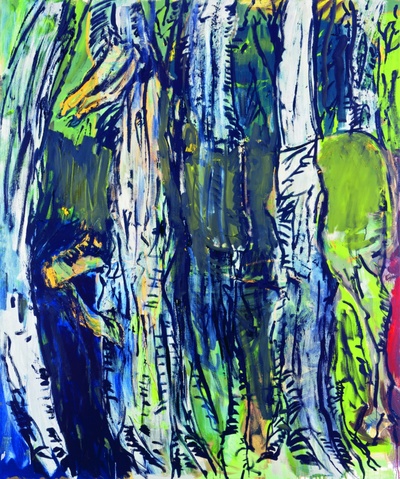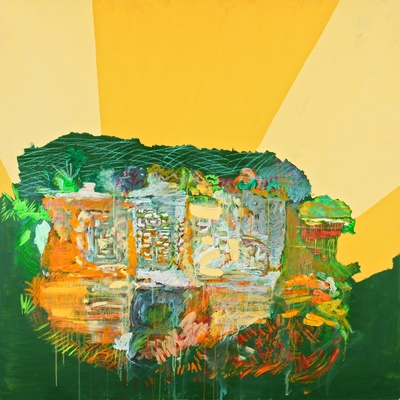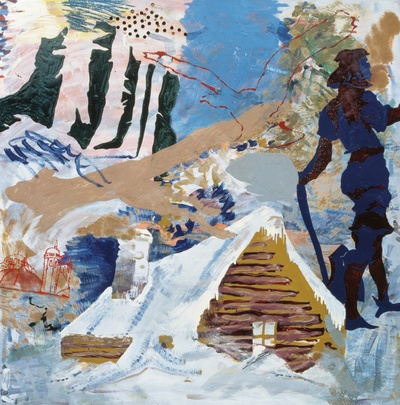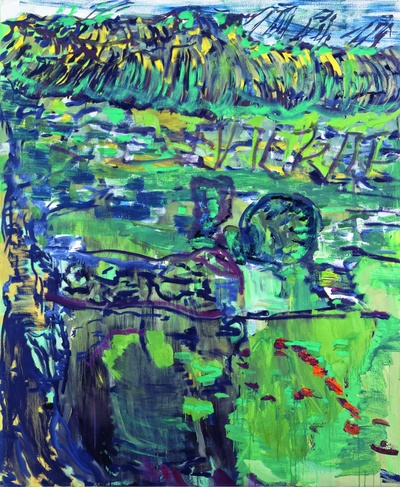Per Kirkeby
By Henry McMahon
Per Kirkeby: Paintings and Sculpture, The Phillips Collection’s survey of works by the 74-year-old Danish artist, is a must-see exhibition for anyone who has walked through that museum’s collection of early modernist masters wondering which, if any, of today’s painters have picked up the project they bequeathed to us.
Per Kirkeby, A Picture of Yucatan, 1972–73. Mixed media on Masonite,
48 x 48 in. ARoS Aarhus Kunstmuseum, Aarhus, Denmark
That Kirkeby’s paintings hold their ground on the top floor of the museum—without the letdown that generally accompanies the shift from viewing past masters to contemporaries—is a testament to the painter’s great intelligence and vitality. It is also a reminder that the project of painting is, in the best of cases, a continually developing and continually relevant conversation with the past. Kirkeby is linked to his forbears by his restless probing of the medium’s potential to give voice to the totality of our lived experience. Using dramatic shifts of color, scale and form in otherwise literal spaces, Kirkeby draws attention to the great flux of the material world that we synthesize into the coherent experience of seeing.
Kirkeby was trained as a geologist before he took up painting. That scientific background is often cited as providing the formal and ideological framework for his paintings, in which large interlocking slabs of color collide in the formation of powerful abstract compositions. Kirkeby’s self-described “likening painting to the process of sedimentation” is on prominent display in the exhibition, and the artist’s fascination with the construction of the natural world is reflected in each of the twenty-six paintings and eleven sculptures on view. He plies the properties of the medium (at first common house paint, then oil, and more recently tempera) in the service of suggesting all the thinness and density, transparency and opacity, light, color, and form that make for the distinctions between things in our optical experience of the world. His sculptures, too—the dense, blocky bronzes that are equal parts material as they are recognizable objects—reflect the primacy of materiality.
Per Kirkeby, Regicide at Finderup Barn, 1967. Mixed media on Masonite,
48 x 48 in. Louisiana Museum of Modern Art, Humlebaek, Denmark.
Acquired with funding from the Otto Bruun Foundation
Per Kirkeby, Fram, 1982. Oil on canvas, 46 1/2 x 78 3/4 in.
Louisiana Museum of Modern Art, Humlebaek, Denmark
As an earth scientist, Kirkeby’s fascination clearly lies in the materiality of the natural world. As a painter, however, his fascination lies chiefly in the informed treatment of optical space. The latter of these twin fascinations links him to the painters on view in the rooms below (Cézanne, Renoir, Matisse and Picasso), while the former provides the context through which his investigation of the medium has resulted in a unique and substantial continuation of their project.
When Kirkeby began painting in the 1960s, his were Pop-influenced works in which recurring symbolic motifs were arranged, collage-like, into fantastical spaces. A number of such works are on view in the Phillips exhibition, including Regicide at Finderrup Barn and Dark Cave (The Dream about Uxmal and the Unknown Grottoes of Yucatan), both dating to 1967. Regicide depicts a snowed-in log cabin, the figures of a woodsman with an axe, a flying bird, and a darting fox arranged around it to suggest the disturbance that has taken place there. Dark Cave situates us inside a cave, looking out through its mouth into the distant landscape, but up, also, at its walls and ceiling, which have been decorated with strokes of paint. These images, which play on the mythology of Germanic and Mayan cultures, reflect Kirkeby’s early interest in the narrative possibilities of painting. They also hint that space would emerge as one of Kirkeby’s abiding concerns, changing his narrative from one of storytelling to one of seeing.
Per Kirkeby, Prisoner of the holy agony I, 2009. Tempera on canvas,
70 3/4 x 59 in. Courtesy Michael Werner Gallery, New York, London, and Berlin
If you take a formal element of Kirkeby’s early works and follow it into his mature paintings, which begin in earnest around 1980 and comprise the majority of the Phillips exhibition, you can see how his language develops to address this big theme; that is, how our experience of the world is informed by the complexities of seeing. Let’s take scale, which in the mature works is used to create space by both conventional means (large forms come forward, small forms recede, those that overlap find their relative places as a result), and by unconventional ones (wherein, for instance, a grove of distant trees will be painted on top of a form in the near space). The function of the conventional scale is obvious enough; it creates literal space. To understand the function of the unconventional scale shifts, it’s helpful to have Kirkeby’s early works nearby. Outsized scale, used in works like Regicide to emphasize narrative components (The bird has taken flight! The fox has darted away into the night!), has been repurposed in the mature works to emphasize the narrative of looking.
Imagine pondering a distant mountain and then snapping your focus onto a branch only a few feet from your eyes. The two points of focus present dramatically different yet equally true experiences of the visible world. The veracity of these simultaneous focal points, and the tensions between them, are an integral part of our visual experience. The act of seeing is a narrative one, in which our eyes take in and synthesize any number of forms in space. Kirkeby draws our attention to this narrative by freezing it, and painting any forms he can think of into his frozen space. In a masterful manipulation of the formal language of painting, he articulates the many simultaneous experiences of looking that are synthesized into our optical experience of the world.
Kirkeby is bothered by the “landscape” interpretation of his paintings, likely because the implied stasis of the genre fits his works so poorly. His unique and jarring use of scale, color, and form make for works that communicate a world in deep and constant flux.
Per Kirkeby, Untitled, 1982. Chalk and blackboard paint on Masonite,
48 x 48 in. Courtesy Michael Werner Gallery, New York, London, and Berlin
Kirkeby’s first criterion for an analog of our visual experience of the world is the creation of literal space. Works like Prisoner of The Holy Agony I, 2009, which takes our eye to a distant mountain range, or Untitled, 2006, in which sea and sky meet on a horizon, use relatively straight means—receding planes of water, shifts in color and scale—to create the illusion of depth. Kirkeby’s lines (strong drawing unifies each of the works on view) give shape to his forms and articulate their position in space. Lily pads, for instance, are described as ellipses that recede in accordance with the recession of the water they float on. Mountains that rise from plains; shelves of rock that pile on top of one another; trees that stand in groups; felled trunks that lie on their sides: each of these overt figurative forms is described as a volume in real-world space.
Having established a literal space, Kirkeby uses surprising shifts in color and form the same way he uses shifts in scale, to suggest the complexity that underlies our visual experience of the world. The paintings are as full of amorphous color areas as they are of overt figures. Take the bright solid horses that stand in the near-ground in Untitled, 2009, the largest painting on view. The bold figuration of the horses comes as a surprise amidst the aggressively abstract landscape that surrounds them. Our eye flickers between the horses and landscape, between figuration and abstraction, between bright and muted color. This dance is repeated throughout the mature works. Abstract masses bump up against figurative ones, bright yellows collide with warm purples, and light-filled transparent washes mix among areas of impossibly dense opacity. A tree-trunk jumps out through a dense forest. A horse emerges from a stand of trees with no regard for the conventions of positive and negative space.

Per Kirkeby, Untitled, 2009. Oil on canvas, 70 3/4 x 59 in.
Courtesy Michael Werner Gallery, New York, London, and Berlin
The effects of these works are spellbinding. Articulating the great flux of our visual experience before the moment of synthesis, Kirkeby makes for strikingly beautiful insights into how we experience the world. His dance—between color and form, figuration and abstraction, and near space and distant—suggests a worldview in which everything that makes up our visual landscape has a palpable bearing on our experience.
Henry McMahon is a writer and painter based Brooklyn, New York.
All images supplied courtesy of The Phillips Collection, Washington DC





